Once the product arrived at my doorstep I gingerly picked it up as not to damage what I sincerely hoped was the final long-lasting cure to my ailment. What follows is my description of just how this cure was implemented to stem the rising temperature issues associated with my disease. Will this product, the Noctua NH-U12F, cure my ills or will I lapse into the final stages of this deadly disease? Join me and we’ll soon find out!
INTRODUCTION
Like hundreds of thousands of Computer Enthusiasts I was recently smitten with a common ailment “Upgraditis” which was rapidly diagnosed by my fellow proteges at Bjorn3d. Once the diagnosis was confirmed it was time to act quickly less the disease progress to the more advance stages. The tests rapidly showed that I had a very common strain of the disease called “Conroeferomonitis” which is more commonly referred to as “Conroe Syndrome”. Most of us that have suffered from this ailment know quite easily how to cure the disease but also know the treatments can be quite expensive. Well, rather than prolonging my suffering anymore I decided to opt for the Level 3 cure also known by most as the “E6600”. After receiving this treatment posthaste my symptoms immediately got better and I felt complete recovery was imminent. Little did I know!
It appears the complexity of this strain of the disease was much more engrained than I initially realized. After doing much research I found that a complete cure could only be realized with the use of other therapeutic agents. One by one I again researched what I felt would be the best remedies and ordered them from computer-pharmacies far and wide. After all treatments arrived and were implemented I still had one clearly evident symptom which might be the hardest to cure an ever-present temperature issue. I wrote to all my sources for suggestions to my return to complete freedom from this improving illness and low and behold an Austrian company by the name of Noctua sensed I needed help and responded without my ever notifying them. Hopefully all my problems would soon be solved in just a few days.
Once the product arrived at my doorstep I gingerly picked it up as not to damage what I sincerely hoped was the final long-lasting cure to my ailment. What follows is my description of just how this cure was implemented to stem the rising temperature issues associated with my disease. Will this product, the Noctua NH-U12F, cure my ills or will I lapse into the final stages of this deadly disease? Join me and we’ll soon find out!

Noctua: A Brief Overview
Noctua arises from a cooperation between the Austrian Rascom Computerdistribution Ges.m.b.H and the Taiwanese Kolink International Corporation and entertains a development partnership with the Austrian Institute of Heat Transmission and Fan Technology (Österreichisches Institut für Wärmeübertragung und Ventilatorentechnik, ÖIWV). These connections form the key to the achievement of our goal: The partnership with the ÖIWV permits the application of scientific measurement instrumentation, methods of calculation and simulation technology in the R&D process. Rascom’s long, customer-oriented experience in developing and distributing sound-optimised high-end products ensures a clear focus on the users’ needs. The use of Kolink’s advanced manufacturing technology and ultra-modern production plants allows us to efficiently implement our technical edge and provide solutions of the highest standard in quality and performance at a fair price.
THE COOLER
When I first spoke with the marketing representative from Noctua, I was informed that they would not only be sending me the Noctua NH-U12F CPU cooler, the latest iteration of their already immensely popular NH-U12 cooler. I was also informed that a newly designed and somewhat revolutionary NF-S12 fan would be accompanying the cooler for review. Much to my amazement when I received the package direct from Austria and opened the secure shipping container there was not only the CPU cooler and one fan, but two additional fans. As it turns out there are two versions of the fan which will be covered later in this review.

Noctua NH-U12F CPU Cooler
While similar in looks to its predecessor the NH-U12, the NH-U12F rectified a couple of minor issues that were noted with the NH-U12. The NH-U12F can be rotated by 90° on all sockets, boasts full compatibility with AMD’s new AM2 socket and comes equipped with a Noctua NF-S12 120mm fan, which has a minimum noise rating of only 8dB(A). The NH-U12F has 4 Dual-Heat-Pipes, 38 aluminium cooling fins with a total surface area of more than 5000cm² and soldered joints for optimal heat-transfer.
Upon removing the cooler’s packing I was in awe of all the included accessories that come with the NH-U12F. The image below will give you some idea of exactly how impressive the included accessories really are. Note: I intentionally didn’t include the fan with the accessories even though it was in the package as we’ll view it much more closely later in the review.

Noctua NH-U12F & Bundled Accessories

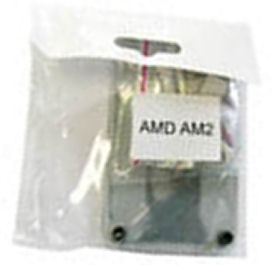
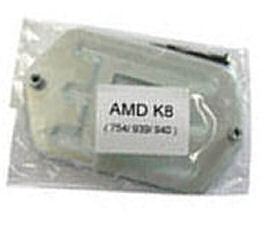
Mounting Accessories for Most Common Sockets
The following images may help to give you a better perspective of: 1) The size of the HH-U12F; 2) The design of the coolers heat pipes; and 3) The quality of the workmanship.
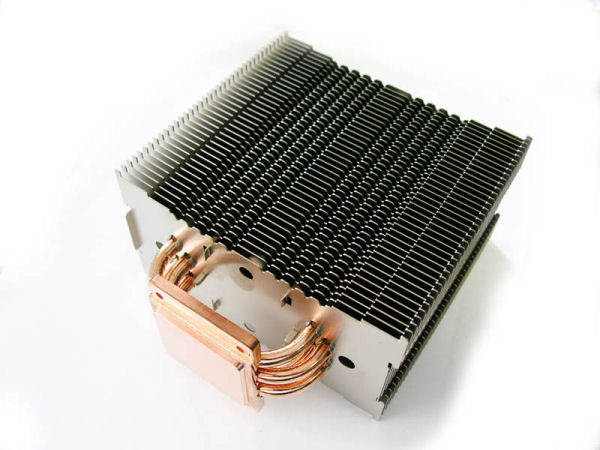
Noctua NH-U12F … Side View
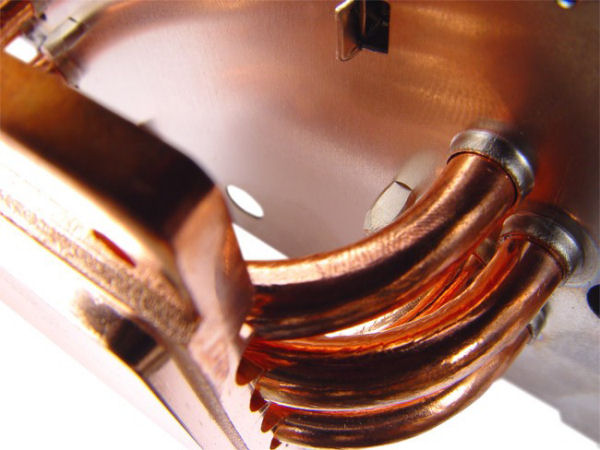
Noctua NH-U12F … Heat Pipes

Noctua NH-U12F … Mounting Area
THE COOLER cont.

Noctua NH-U12F … Lower Half

Noctua NH-U12F with NF-S12 Fan Mounted
Features
- 4 Dual-Heatpipes for optimal heat absorption: The 4 u-shaped Dual-Heat-Pipes have a huge contact area with the copper base to efficiently absorb the CPU’s heat. They form 8 risers to spread the heat throughout the fins.
- 38 aluminium cooling fins for optimal heat dissipation: Thanks to a surface area of more than 5000cm², the cooling fins dissipate the heat extremely fast. Both the choice of aluminium and the fins’ shape and spacing allow for outstanding cooling performance with the supplied ultra silent NF-S12-1200 fan.
- Soldered joints for optimal heat-transfer: Unlike many other coolers, whose heat-pipes are stuck to the base and the fins, the Noctua NH-U12F possesses high-grade soldered joints to ensure optimal heat transfer.
- Noctua NF-S12-1200 fan with Ultra-Low-Noise adaptor: Thanks to the sound-optimised blade geometry of the Noctua Straight-Blade-Design and the self-stabilising oil-pressure bearing (SSO bearing), the NF-S12-1200 achieves a flow rate of 81m³/h at a noise rating of only 17dB(A). Using the supplied Ultra-Low-Noise adaptor, the noise level can be lowered to only 8dB(A)!
- Screwless fan-mount including anti-vibration strips: Attaching the fan with the steel clips is a child’s play and doesn’t even require a screwdriver. The supplied anti-vibration strips minimize vibrations transmitted to the cooler and hence allows for extra quietness.
- Easy installation on socket LGA 775, K8 (754, 939, 940) & AM2: The NH-U12F fits Intel’s socket LGA 775 as well as AMD’s K8 (754, 939, 940) and AM2. Thanks to the detailed step-by-step installation guide, installation only takes a few minutes!
- SecuFirm™ mounting system: The SecuFirm™ mounting system guarantees optimal contact pressure and maximum security thanks to the use of a backplate and spring-loaded screws. As a result, the SecuFirm™ mounting system makes it possible to safely transport the assembled system without any risk even though the cooler exceeds the 450g weight specification established by Intel and AMD. Perfect for LAN gamers!
- Can be rotated by 90° for improved compatibility and optimal positioning within the case: The NH-U12F can be installed rotated by 90° on all compatible sockets to allow for an optimal positioning of the cooler within the airflow inside the case and to evade compatibility issues.
- Including manual, thermal paste and mounting hardware: In addition to the mounting hardware, the manual and the NF-S12-1200 fan, the package contains a syringe of high-grade thermal paste so that you can get started right away!
Specifications
NOCTUA NH-U12F SPECIFACTIONS |
Socket Compatibility
Intel Socket LGA 775, AMD K8 (754, 939, 940) & AM2
Height (without fan)
155mm
Width (without fan)
126mm
Depth (without fan)
70mm
Height (with fan)
155mm
Width (with fan)
126mm
Depth (with fan)
95mm
Weight
790 g
Material
Copper (base and heat-pipes), aluminium (cooling fins), soldered joints
Application
Intel all frequencies, AMD all frequencies
Fan Size
120x120x25mm / 120x120x38mm (2 fans mountable)
Included Fan
Noctua NF-S12-1200
Bearing
SSO-Bearing
Blade Geometry
Straight-Blade Design
Rotational Speed (+/- 10%)
1200 RPM
Rotational Speed with U.L.N.A. (+/- 10%))
800 RPM
Airflow
81 m³/hour or 47.7 cfm
Airflow with U.L.N.A.
59 m³/h or 34.2 cfm
Accoustic Noise
17 dB(A)
Acoustical Noise with U.L.N.A.
8 dB(A)
Input Power
1.44 W
Input Current
0.12 A
Voltage Range
4 – 13 volts
MTBF
> 150,000 hours
Scope of Delivery
- NH-U12F
- NF-S12-1200
- Complete mounting hardware
- Ultra-Low-Noise Adaptor (U.L.N.A.)
- Thermal PasteAnti-Vibration-Strips
Warranty
6 years
THE FAN
I’ve always been a very strong proponent of having a system that performs to its potential without excessive overclocking, is as cool as possible, and is as quiet as possible considering the first two attributes. All we need to do is produce completely silent fans that move massive volumes of clean, cool air into our power hungry, fire-breathing systems. There’s what the consumer needs, you find the solution and I’ll be the first to invest in you new multi-million dollar company!
Seriously though after reading in depth about the technology behind being used with the Noctua NF-S12 fans, I believe they have concept that will carry them to a high degree of popularity amongst Enthusiasts and the Silent PC lovers alike. I was supplied with both the NF-S12-1200 and NF-S12-800 versions of the fan for testing. The technology behind the fans and their specifications follow.
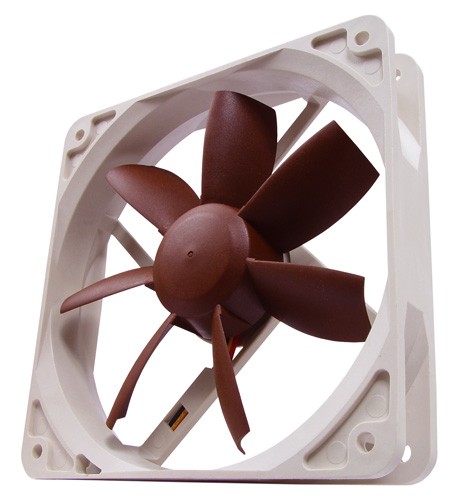
Noctua NF-S12 Fan

Noctua NF-S12 Fan … Package w/Accessories
Straight Blade Geometry
Current silent fans frequently employ conventional blade geometries, which were developed for higher speed ranges and significantly lose efficiency at lower rotation speeds. The Noctua Straight-Blade-Design of the NF-S12 series was developed by the Austrian Institute for Heat-Transmission and Fan Technology (Österreichisches Institut für Wärmeübertragung und Ventilatorentechnik, ÖIWV) and specifically tailored to 120mm fans with extremely low rotation speeds. The result is a performance improvement of up to 10% and more compared to conventional blade geometries.
The Straight-Blade-Design of the NF-S12 series provides the maximum efficiency of a straight fan blade without the drawback of higher noise emission, which arises when straight blades are used at higher rotation speeds. At the low rotation speeds of the NF-S series, the Noctua Straight-Blade-Design achieves a significantly higher flow rate than forward or backward swept blade designs. Furthermore, among other measures to prevent vortices like the rounded rotor hub, the distance between rotor and stator (tip clearance) was increased in order to reduce the problem of tip vortices which plays an important part in the noise emission of axial fans. With its fan blade exactly tailored to ultra low noise application, the NF-S12 series is significantly more quiet than other high end silent fans.
Mag. Manfred Stadler MBA of the Austrian Institute for Heat-Transmission and Fan Technology (Österreichisches Institut für Wärmeübertragung und Ventilatorentechnik, ÖIWV) about the development of the Noctua Straight-Blade and Raised-Blade-Designs: “In the area of PC cooling, the last years saw a growing demand for axial fans with the lowest possible noise emission, which manufacturers mostly met by simply reducing the RPM of existing models without sufficiently adapting the blade geometry and profile to the modified fluid dynamic parameters. The comparison of measured data and simulation outputs showed that the result was an average deficit of efficiency of 10-15%. The complete redevelopment of the blade geometry and profile was carried out with exact fluid mechanical adjustment to minimal noise emission in a speed range of 400-1600RPM at a height of 25mm and a radius of 40 and 60mm. Both fan blades possess 8-12% more flow rate than comparable products at the same total noise emission and static pressure.” (Mag. Manfred Stadler MBA, Austrian Institute for Heat-Transmission and Fan Technology (Österreichisches Institut für Wärmeübertragung und Ventilatorentechnik, ÖIWV))
THE FAN cont.
Self-Stablishing-Oil Pressure Bearing (SSO)
The NF-S12 series are equipped with a magnetically centred, self lubricating oil-pressure bearing that provides a new level of quietness and long-term stability. Thanks to an optimised principle of operation, the self-stabilising oil-pressure bearing (SSO bearing) of the Noctua NF-S12 and NF-R8 series surpasses current types of ball, sleeve or liquid bearings in terms of long-term stability and quietness.
The rotary motion of the axis generates pressure upon the special oil enclosed within the bearing. This causes the build-up of a dynamic pressure field that centres and stabilises the axis within the bearing shell. While conventional liquid bearings employ the principle of hydrodynamic pressure too, the SSO bearing is equipped with an additional magnet that supports the self-stabilisation of the rotor axis. This allows for a faster, more precise and more reliable centring of the rotor axis and thus increases the long-term stability and quietness of the bearing: When the fan starts, the dynamic pressure field of the liquid bearing needs to build up first, which results in an initial precession of the axis, the so called gyro effect. This amounts to an increased abrasion until the axis is stabilised through the build-up of the dynamic pressure field, which may by and by lead to increased noise emission and bearing defects. Because of this, the SSO bearing possesses a built in magnet, whose field ensures the immediate self-stabilisation of the rotor and hence reduces the gyro effect. In addition to the stabilisation during the start-up phase of the fan, the supporting magnet allows for a more exact centring of the axis within the bearing shell and thus further reduces bearing resistance, abrasion and noise emission.
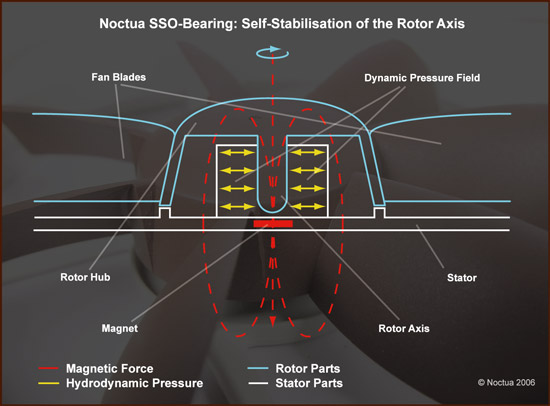
Graphical SSO Bearing Principle
The sleeve and ball bearings currently predominating the fan market exhibit major drawbacks: While conventional sleeve bearings initially have very low noise emissions, they mostly possess unsatisfying long-term stability, which leads to a short overall lifespan and increasing noise after longer operating times. High grade ball bearings, on the other hand, while providing satisfying long-term stability operate at slightly higher noise levels from the beginning. The SSO bearing not only surpasses the quietness of conventional sleeve bearings but also the long-term stability of current top-of-the-line ball bearings.
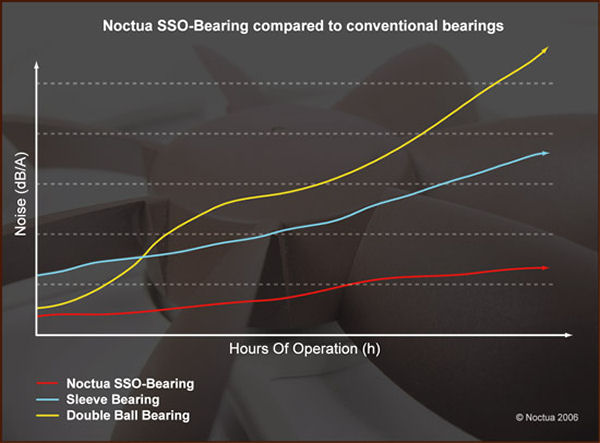
Graphical SSO Bearing Compared to Conventional Bearings
Specifications
NOCTUA NF-S12-1200 SPECIFACTIONS |
Fan Size
120x120x25mm / 120x120x38mm (2 fans mountable)
Bearing
SSO-Bearing
Blade Geometry
Straight-Blade Design
Rotational Speed (+/- 10%)
1200 RPM
Rotational Speed with U.L.N.A. (+/- 10%))
800 RPM
Airflow
81 m³/hour or 47.7 cfm
Airflow with U.L.N.A.
59 m³/h or 34.2 cfm
Accoustic Noise
17 dB(A)
Acoustical Noise with U.L.N.A.
8 dB(A)
Input Power
1.44 W
Input Current
0.12 A
Voltage Range
4 – 13 volts
MTBF
> 150,000 hours
Scope of Delivery
- Ultra-Low-Noise Adaptor (U.L.N.A.)
- 4 Vibration Compensators
- 3:4-Pin Adaptor
- 4 Fan Screws
Warranty
6 years
NOCTUA NF-S12-800 SPECIFACTIONS |
Fan Size
120x120x25mm / 120x120x38mm (2 fans mountable)
Bearing
SSO-Bearing
Blade Geometry
Straight-Blade Design
Rotational Speed (+/- 10%)
800 RPM
Rotational Speed with U.L.N.A. (+/- 10%))
500 RPM
Airflow
59 m³/hour or 34.2 cfm
Airflow with U.L.N.A.
34 m³/h or 20 cfm
Accoustic Noise
8 dB(A)
Acoustical Noise with U.L.N.A.
< 5 dB(A)
Input Power
.60 W
Input Current
0.05 A
Voltage Range
6 – 13 volts
MTBF
> 150,000 hours
Scope of Delivery
- Ultra-Low-Noise Adaptor (U.L.N.A.)
- 4 Vibration Compensators
- 3:4-Pin Adaptor
- 4 Fan Screws
Warranty
6 years
INSTALLATION: COOLER & FAN
The installation process of the NH-U12F requires removal of the motherboard from the case, but other than that minor inconvenience would not consider it to be the least bit difficult. You also have the ability to mount the cooler at opposing 90 degree angles to best fit the needs of the motherboard and case that you are using. Since my test system is a Socket 775, I will detail that installation using step by step instructions found in the installation manual. Although, I didn’t attempt installation on any of the other socket style boards, the included thorough instructions make their installation look equally as easy as the 775 process.
First select the coolers desired orientation:

Screw the mounting bars to the back plate using small screws and washers:
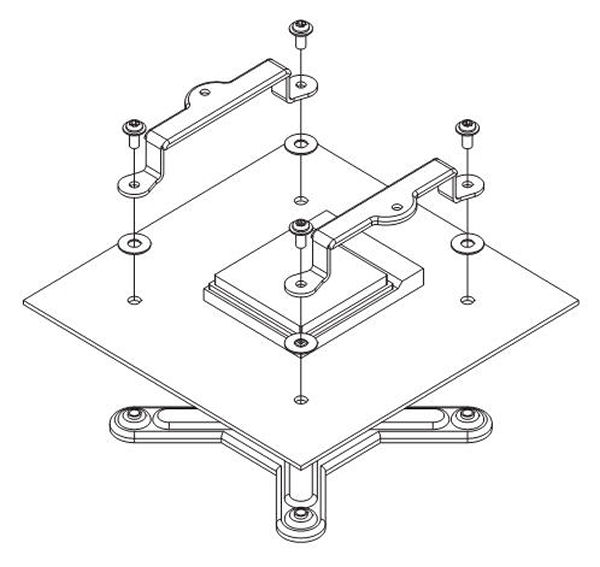
Tightly screw the fastening brackets to the copper base of the heatsink using four (4) short screws:
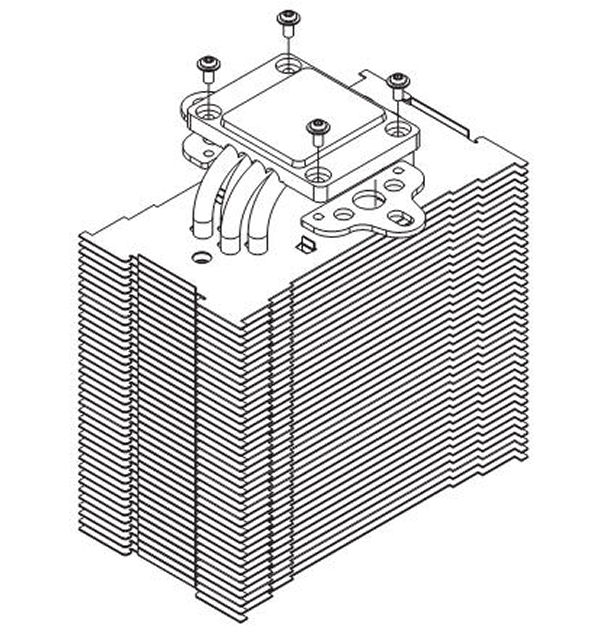
Next, apply thermal compound. Place the heatsink on the CPU so that the mounting holes of the the fastening bracket screwed to the base of the cooler align with those of the mounting bars. Now screw the fastening brackets to the mounting bars employing the pressure springs and respective screws.
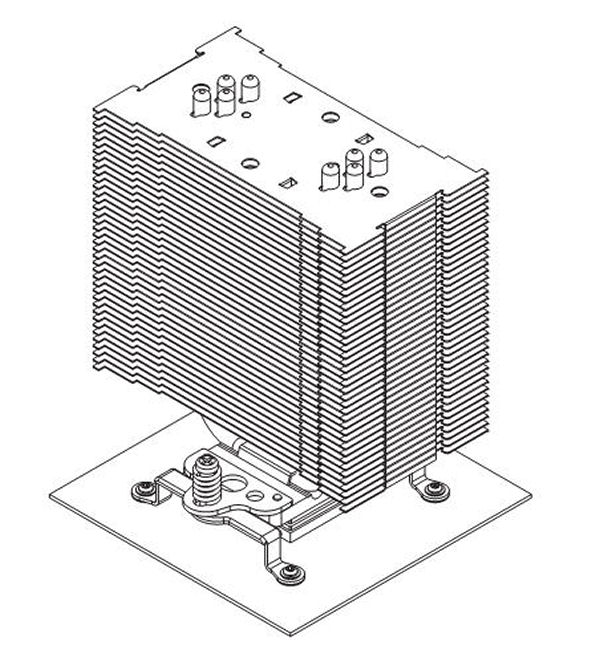
Stick the anti-vibration strips on to the cooling fins in order to dampen minor vibrations emitted by the fan.
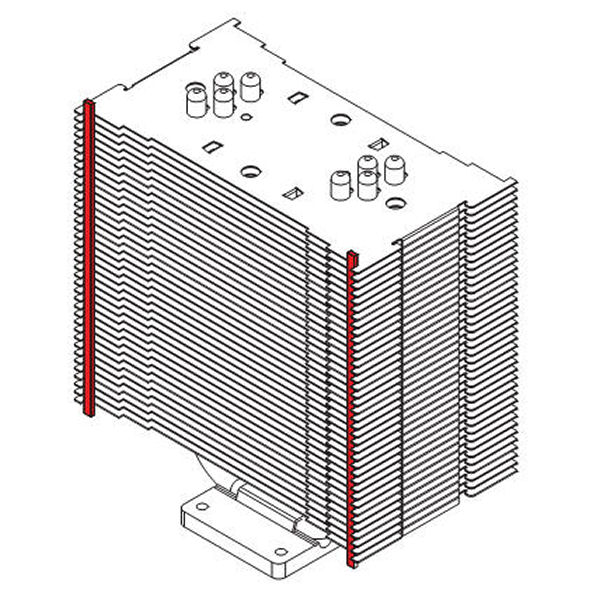
Attach the fan to the heatsink using 2 steel clips placing the fan in such a manner that it blows onto the heatsink. Note: An second set of clips is provided so that you may install a second fan in a push-pull configuration should you have the room and desire this option.

Finally, connect the fan to a power connector on either the motherboard, power supply, or fan controller.
TESTING
Test System
- Asus P5WDG2 WS Professional Motherboard
- Intel E6600 Core 2 Duo (Conroe) Processor at default speed
- Test Cooler 1: Noctua NH-U12F CPU Cooler with included Noctua 120mmm NF-S12-1200 Fan
- Test Cooler 2: Scythe Ninja Rev B Plus CPU Cooler with included Scythe 120mm AMD1212DS fan
- Test Cooler 3: Zalman CNPS9500-LED CPU cooler with integrated fan
- 2GB of Mushkin Redline XP2-8000 DDR-2 (4-5-4-11-1T @ 2.0 volts)
- LeadTek WinFast PX7950 GX2 TDH running ForceWare 91.47 drivers
- 2 – Seagate 750GB Barracuda SATA drives
- Creative Audigy 4 Sound Card
- Corsair CMPSU-620HX 620 PSU
- Lian-Li G70 Case customized by Performance PCs
- Windows XP Pro SP2
- Samsung Syncmaster 213T 21.3″ LCD Monitor
Test Methodology
We have had a chance to look at the beauty and craftsmanship of the NH-U12F as well as discuss the evolutionary changes that have taken place in direct response to customer and reviewer’s responses to its predecessor. Now it’s time to get to the meat of this review! How does this product perform? Before going into the test methodology we must state a fact that is known already by most the Core 2 Duo (Conroe) owners, this processor screams. Even though rated at 65 Watts of heat production, the architecture of this chip produces a fair amount of heat so we decided to use the Intel Core 2 Duo E6600 for our test unit in the NH-U12F’s evaluation. We also decided that the review of a single cooler without others to compare it to would be rather boring so we’ll use the Scythe Ninja Rev B Plus CPU Cooler with included Scythe 120mm AMD1212DS fan and the Zalman CNPS9500-LED CPU cooler with integrated fan for comparison purposes. Both are considered worthy adversaries by many Computer Enthusiasts and reviewers.
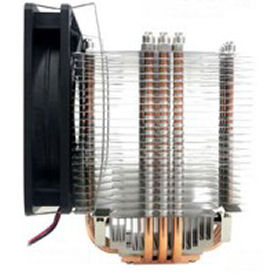
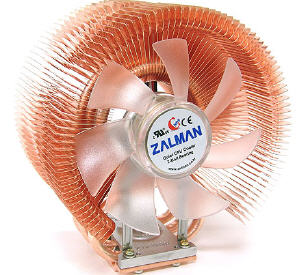
The Competitors: Scythe Ninja (left) & Zalman 9500LED (right)
The test methodology is quite simple we’ll be using Intel’s Thermal Analysis Tool to push the processor to its utmost performance level. We feel this product currently does a better job of loading the processor to its “full load” capacity than any other tool currently available. Before testing we made certain that the contact surface of each cooler and the CPU was completely clean and free of any oxidative materials that would skew the results. We also assured each cooler was mounted properly and optimal contact established. We used Artic Ceramique as our thermal compound of choice and applied it as we have done numerous times using the manufacturer’s specified instructions. We then allowed each the thermal compound to cure for 48 hours give or take a few each minutes for optimal results.
Once each cooler was prepared and ready for testing we disabled any unnecessary processes running in the background. The processor was then allowed to achieve an idle state for twenty minutes with no human intervention. The 100% load was achieved in a similar fashion with Intel® Thermal Analysis Tool running at 100% “Workload Level” on each of the CPU’s core and “On Demand Throttle” was set at 0%. We then took an average of the two core temps to report in the following graphs. The CPU was run at a stock speed of 2.4 GHz at both idle and load and then moderately overclocked to 3.2 GHz also at idle and load. The mean ambient temperature was kept as close to 25 degrees Celsius as possible during the testing. The system temperatures, even at overclocking rates, never reported higher than 35 degrees Celsius. The tests were run identically on both the stock and overclocked configurations, and the results reported as follows:
Test Results


CONCLUSION
As you can readily see there is a significant difference between the Zalmann CNPS9500-LED and the other two coolers in some cases as much as 10 degrees Celsius. Concerned that the Zalmann might not be making good contact I repositioned it several times and looked at the thermal lubricant smear on the cooler surface after each set of tests to assure a fair and impartial set of results were reported. I should also state that I’m running all of these tests in a Lian Li G70 Case custom built to my specifications by Performance PCs Inc. There are 6 – Scythe 120mm fans running inside the case, not including the CPU cooler fan at all times, so there is no lack of airflow for the components. I expected the competition between the Noctua NH-U12F and the Scythe Ninja would be much closer as I had seen in previous tests by other reviewers, in fact the Noctua NH-U12F using the NF-S12-1200 was the clear winner beating the Scythe Ninja by an average of 2-3 degrees Celsius in all testing.
I must also mention that prior to this test I was sold on the Scythe fans and firmly convinced that they had the best volume output to silence ratio on the market. This test changed my opinion completely. The Noctua S12-1200 is far quieter from an extremely subjective standpoint on the part of this reviewer. Running the fan at 1200 RPMs it was barely audible and at 800 RPMs the fan was inaudible. The output difference between the Scythe and the Noctua was minimal with the Scythe producing around 5 CFM more. As long as we’re in the ballpark temperature wise at my desired settings, I’ll take quiet over 1 or 2 degrees Celsius any day! I should note that this subjective impression of “quiet” will be this reviewers last! This review and ones similar to it finally prompted me to buy a quality Sound Level Meter, the Omega HHSL-1, which will be used on all future reviews where the subject of a products “objective quiet traits” are in question.
The only real issue I have with the Noctua NH-U12F is not specific to this cooler alone, but to many of the new mammoth designs currently being showcased in today’s cooling market. The do an excellent job of cooling the CPU, but the system’s Mosfets and other internal passive cooling components receive little if any airflow from this cooler design. This necessitates a separate fan to help cool these components especially with moderate to extreme overclocked CPUs. Coolers like the Thermaltake Big Typhoon and the Thermalright SI-128 not only cool well, but also provide a secondary pass-through cooling of the aforementioned components. I’m not supporting one design over the other, I’m simply stating the obvious.
One final issue I almost forgot, the spacing of the fins on the Noctua Nh-U12F is wide enough where fans delivering less CFMs will work as well as those delivering a higher range. With more, yet tighter designed fins a higher output and thus generally noisier fan is required to achieve the same level of cooling. I wanted so much to set this cooler up with the two NF-S12-1200 fans that were supplied in a push-pull configuration as I believe that would have improved even more on this coolers already stellar performance. However, physical system limitations prevented me from testing and reporting on this configuration.
I should also state that currently the Noctua NH-U12F cooler and the NF-S12-1200 fan are not currently available in the US market, but I’m expecting that to change in the next few weeks. I can only guess that the price of the cooler will be comparably priced with its predecessor in the $50 – $60 USD range and the fan priced comparably with the competition’s products. As is clearly obvious, Noctua has not one but two extreme winners on their hands and I just hope the supply when this fan becomes available will meet what I perceive the desired demand to be. The Noctua NH-U12F also has one of the best machined contact areas that I have ever seen on a non hand lapped cooler. Finally, can I recommend these products? The answer is quite simple and only two words long HELL YES, these two products kick some major ass in the cooling arena both as a team and separately.
Pros:
+ 4 Dual-Heatpipes
+ 38 aluminium cooling fins
+ High-grade soldered joints
+ Easy installation on socket LGA 775, K8 (754, 939, 940) & AM2
+ Can be rotated by 90° for improved compatibility and optimal positioning
+ Excellent cooling
+ Extremely quiet supplied fan
Cons:
– Lack of ventilation for the system’s Mosfets and other internal passive cooling components
Final Score: 9.0 out of 10, and the coveted Bjorn3D Golden Bear Award
 Bjorn3D.com Bjorn3d.com – Satisfying Your Daily Tech Cravings Since 1996
Bjorn3D.com Bjorn3d.com – Satisfying Your Daily Tech Cravings Since 1996




